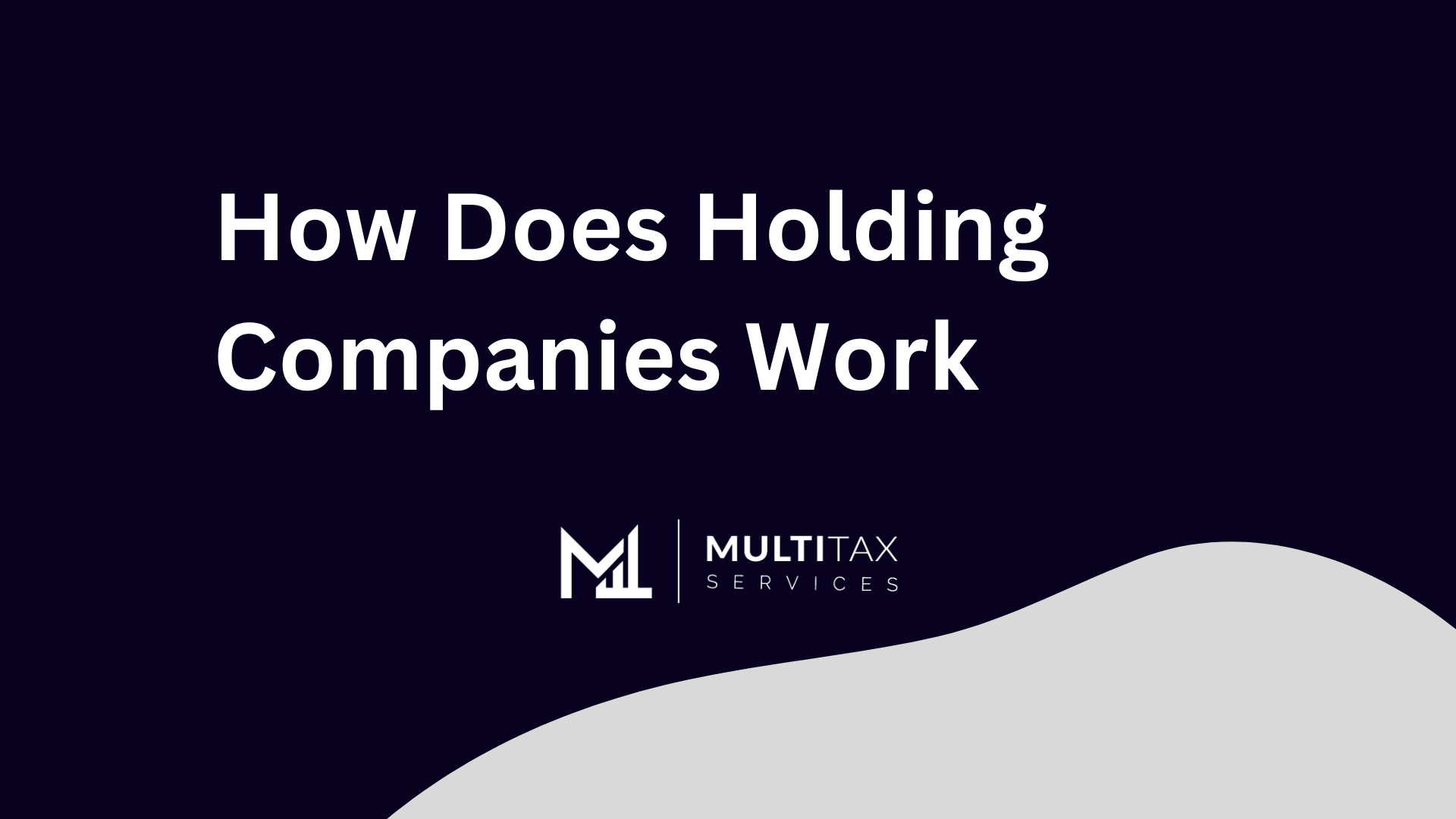Ever wondered how holding companies work? They are like big bosses that control other businesses. Holding companies can help make things run smoother and buy new companies.
But, managing them can be tricky because of rules and making sure everything is done right. Learn all about holding companies in this article – their structure, benefits, and types.
Let’s understand how they work. Exciting stuff ahead!
Key Takeaways
- Holding companies generate income through dividends, interest, management fees, and capital gains.
- They diversify their investment portfolios to manage risk and maximize growth opportunities.
- Holding companies benefit from passive income through royalties, licensing, and intellectual property.
- Holding companies provide strategic oversight, asset protection, tax savings, and long-term growth opportunities for subsidiaries.
1. How Holding Companies Generate Income

Holding companies generate income through various revenue sources. One way is through dividends received from their subsidiaries, which can provide a steady stream of income.
For instance, here’s an article that explains how a holding company works and how you can start one in Canada . Further, if you need assistance in understanding these concepts more clearly or need someone to handle the accounting and regulatory aspects, our accounting services could prove to be a valuable asset.
Holding companies can also earn income through capital gains by selling shares of their subsidiaries at a profit.
Additionally, they can generate income by licensing their intellectual property to their subsidiaries or by providing management services for a fee.
These revenue streams contribute to the overall financial stability and growth of holding companies.
1. Revenue Sources
So, one-way holding companies make money is by getting dividends from their subsidiaries. These dividends are a share of the profits that the subsidiaries make, and they’re given to the holding company‘s shareholders.
On top of that, holding companies can also earn income through interest payments on loans that they give to their subsidiaries. This way, the holding company not only gets a return on its investment but also supports its subsidiaries financially.
This process can seem unduly complex if you are unfamiliar with the intricacies.
That’s why a specialist in corporate tax services can come in handy. Our expertise can guide you through this financial maze, ensuring all goes smoothly.
For more detailed information on this, check out our blog post on what a holding company is and how it functions .
2. Investment Portfolios
So, holding companies also make money by having investment portfolios.
These portfolios include a mix of different financial assets like stocks, bonds, and real estate. The idea here is to spread out the risk and make the most out of the returns.
To do this, holding companies invest in different types of assets and industries.
This way, if one investment doesn’t do so well, it won’t have a huge impact on the overall portfolio. Managing the investment portfolio actively is super important for keeping risks in check and spotting opportunities for growth.
One popular strategy is called asset allocation, where they decide how much of their portfolio to put into different types of assets.
3. Dividend Income
Firstly, holding companies are able to generate a passive form of income by receiving dividends from their subsidiary companies.
This means that they don’t have to actively participate in the day-to-day operations of these subsidiaries to earn money.
It’s a pretty sweet deal, don’t you think?
One major benefit of dividend income is that it provides a consistent and reliable source of revenue for holding companies. This financial stability allows them to plan for the future and make informed decisions about their investments. It’s like having a steady stream of payroll income flowing in, which is always a good thing.
4. Capital Gains
So, capital gains are basically profits that holding companies earn by selling their investments or assets at a higher price than what they initially paid for them.
When a holding company sells a subsidiary or investment and makes a nice profit, that profit is considered a capital gain, and it adds to their overall income.
The cool thing about capital gains is that they often come with some tax advantages. Typically, they’re taxed at a lower rate compared to ordinary income.
Now, here’s where things get interesting. Holding companies can be super savvy by strategically managing their capital gains.
By carefully planning their investment strategies and managing their assets, they can maximize their profits and optimize their overall income and tax liabilities.
5. Royalties and Licensing
So, here’s the deal with generating income through royalties and licensing agreements.
Holding companies are pretty smart when it comes to making money off their intellectual property and assets. They basically take their cool ideas and stuff, and let other people use it for a fee. It’s like getting paid to share your awesomeness!
So, how does it work? Well, holding companies can make moolah by letting their subsidiaries or other companies use their trademarks, patents, or copyrights.
It’s like renting out their intellectual property, and they get paid for it! And the best part is, they don’t have to do much once the agreement is in place. It’s a passive income stream that keeps flowing without them having to get all hands-on.
But wait, it gets even better! Holding companies can also license their brand to other companies. Yeah, you heard it right. They can let other companies use their super cool brand name and all the awesome stuff that comes with it for a fee. It’s like giving someone permission to rock your brand, and you get paid for it. Talk about a win-win situation!
2. Definition and Purpose of Holding Company

So, here’s the deal with holding companies. They’re basically these business entities that are in charge of other companies.
It’s like they’re the boss, but they don’t actually do all the day-to-day stuff. Instead, they make the big decisions and protect the assets of their subsidiaries.
See, a holding company gets control of its subsidiaries by owning most of their shares. That way, it can call the shots without getting too involved in the nitty-gritty details.
This control is important because the holding company needs to be able to oversee and guide the management of its subsidiaries.
One of the main reasons why holding companies exist is to protect assets. By having these subsidiaries under their control, holding companies can shield their assets from all sorts of risks and liabilities.
This is great for the shareholders because it helps safeguard their investments. Plus, holding companies can also benefit from some tax advantages and optimize their tax liabilities. Who doesn’t love saving some money, right?
But that’s not all. Holding companies also makes managing multiple businesses a whole lot easier. Since they’re like the big parent company, they can centralize certain administrative staff and provide support services to their subsidiaries.
This makes it way more efficient to coordinate and allocate resources among all the different companies. And, of course, that means improved operational efficiencies and cost savings.
3. Structure and Function of Holding Company

So, let’s talk about the structure and function of a holding company. It’s actually quite interesting how these companies work.
First off, a holding company’s structure revolves around its ownership of controlling shares or membership interests in subsidiary companies.
Basically, it owns a majority of the shares or membership interests in these subsidiaries, which gives it the power to control their operations and decision-making.
When it comes to corporate governance, holding companies have an important role to play.
They provide oversight and strategic direction to their subsidiaries, making sure that they align with the overall business objectives and adhere to corporate governance principles.
Here, if you need assistance with the legalities of setting up a holding company, we got you covered. Our company registration services can make the procedure simple and efficient
Financial oversight is another crucial aspect of holding companies.
They’re responsible for managing the financial aspects of their subsidiaries, such as monitoring their financial performance, ensuring compliance with regulations, and managing financial risks.
Asset management is also a big part of what holding companies do. They hold assets on behalf of their subsidiaries, like real estate, stocks, or intellectual properties.
And they manage these assets strategically, with the goal of enhancing the value and profitability of the entire group.
Strategic planning is yet another important function of holding companies.
They play a key role in developing long-term goals, identifying growth opportunities, and facilitating the acquisition or divestment of subsidiaries to achieve the overall strategic objectives.
3. Advantages and Benefits

Holding companies have some great advantages and benefits that you should know about. One major advantage is that they can help you save on taxes.
By centralizing ownership of multiple subsidiary companies, a holding company can strategically allocate profits and dividends to take advantage of tax benefits. This means significant savings for shareholders like you.
Another advantage of holding companies is that they offer asset protection.
With limited liability protection, your personal assets are shielded from any business debts or liabilities. This gives you peace of mind knowing that your personal assets are safe.
Holding companies also make strategic management a breeze. By centralizing business operations, decision-making processes become streamlined and oversight becomes more efficient. This means that the holding company can align the strategies and objectives of its subsidiaries, leading to better coordination and overall performance.
In addition, holding companies provide growth opportunities. They’ve the ability to acquire new businesses or assets, allowing for expansion and diversification. This flexibility gives the holding company a competitive edge and the potential for increased profitability.
Lastly, holding companies offer some great financial advantages. They can use lifetime capital gain exemptions when selling operating companies held by the holding company. This can result in potential tax savings, which can further enhance the overall profitability and success of the holding company.
4. Types of Holding Companies
So, let’s talk about the various types of holding companies… For a better understanding of holding companies, you can refer to this blog how to incorporate a business in Canada .
First, we’ve the holding non-operating company. This type of holding company doesn’t have any active operations or revenue streams. Instead, it focuses on managing investments and holding assets. A holding company essentially owns controlling shares in another corporation but doesn’t engage in its own business operations.
Next, we’ve the holding operating company. This type of holding company not only owns controlling shares in another corporation but also conducts its own business operations and generates revenue. So, it combines the benefits of both investment management and business operations.
Lastly, we’ve the subsidiary holding company. This holding company is owned by another entity and holds controlling shares in another corporation. It acts as an intermediary in the corporate structure, facilitating effective control and management of subsidiaries. It also provides a centralized decision-making authority.
Each type of holding company has its own implications for ownership, control, and management. It’s important to understand these differences in order to make the most of holding companies in terms of strategic management, financial benefits, and corporate governance.
5. Examples of Holding Companies
Hey there! Let’s talk about holding companies, using Berkshire Hathaway as a prime example. Now, Berkshire Hathaway is pretty interesting because it owns assets in over 100 public and private companies. As a holding company, it offers a diversified portfolio of investments, which means shareholders can benefit from different industries and markets. That’s a win-win situation!
One major advantage of holding companies is the sweet tax benefits they provide. By setting up their subsidiaries in tax-friendly jurisdictions, holding companies can actually reduce their overall tax liability. Now, who doesn’t love paying less in taxes?
But wait, there’s more! Holding companies like Berkshire Hathaway can also use their financial might and resources to make strategic acquisitions. This allows them to expand their business portfolio and venture into new markets. Talk about taking risks and making big moves!
Another perk of holding companies is the protection they offer to assets. See, since the assets of subsidiaries are separate from the holding company, they’re shielded from any financial liabilities or risks that may come up. It’s like having an extra layer of security for your valuable possessions.
And let’s not forget about the important role holding companies play in risk management. They provide oversight and governance to their subsidiaries, ensuring that they follow regulations and best practices. It’s all about keeping things in check and making sure everyone is playing by the rules.
6. Frequently Asked Questions
1. How Does Holding Company Work?
Holding companies work by owning and controlling subsidiary companies. They offer benefits such as tax advantages and facilitate mergers and acquisitions. Setting up a holding company involves strategic planning and centralized control for managing multiple businesses.
2. How Do Holding Companies Work in Canada?
In Canada, holding companies work by providing tax advantages, legal structure, and strategic acquisitions. They allow you to have ownership and control over other companies while benefiting from financial advantages and streamlined operations.
3. What Are Two Disadvantages of a Holding Company?
Two disadvantages of holding companies are potential conflicts of interest and limited flexibility in ownership. Conflicts can arise between the holding company and subsidiaries, impacting decision-making. Ownership structure may also be restricted, hindering changes to subsidiary ownership.
4. Are Holding Companies a Good Investment?
Holding companies can be a good investment, offering diversification and higher returns. However, before investing, consider factors like regulatory restrictions and compliance costs. Evaluate key financial metrics and compare performance to other investment options for informed decision-making.
7. Conclusion
In short, running a holding company can be tricky because of rules and stuff. But, holding companies have perks like making things run smoother, saving on taxes, and keeping assets safe.
Even though it might cost more money to deal with all this, holding companies are cool for investors looking to grow their businesses later on.


